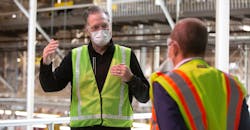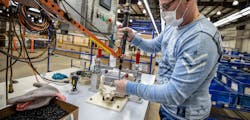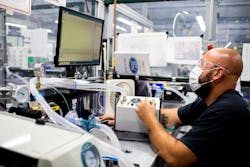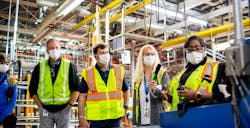2020 Manufacturing Technology Leader of the Year: Ford’s Gary Johnson
To say that 2020 has been an unusual year is an understatement. For most manufacturers, the year has centered on trying to keep up with what appears to be an ever-evolving new normal.
Of course, the unprecedented year also served as an opportunity to demonstrate the many qualities firmly entrenching manufacturers as the heartbeat of the economy: determination, diligence, perseverance and ingenuity. After all, manufacturers proved instrumental in rapidly addressing the dire needs of the medical community in response to COVID-19. This happened through a mix innovative new offerings and dramatic pivots.
This scenario understandably yielded a long list of candidates to choose from when selecting the 2020 IndustryWeek Manufacturing Technology Leader of the Year.
However, Ford Motor Co. quickly surfaced to the top—not only because of its pandemic-related efforts, but also taking into consideration how the automotive manufacturer has become a technology leader.
And the person leading the charge? Ford’s Chief Manufacturing and Labor Affairs Officer Gary Johnson.
Leveraging over 30 years of experience in manufacturing and quality, Johnson is responsible for overseeing the global operations of every Ford assembly, stamping and powertrain plant around the world. Johnson also leads Ford’s global engineering support for stamping, vehicle and powertrain manufacturing, as well as material planning and logistics, the Ford Production System, the manufacturing business office and labor affairs organization.Putting Manufacturing Technology to the Test
Ford’s commitment to play a meaningful role in the pandemic response has been well documented. In late March 2020, Ford made a resounding commitment to pivot away from normal operations to partner with GE Healthcare and deliver 50,000 ventilators. By the end of August, it not only delivered on its ventilator commitment, according to an official statement, but Ford also delivered more than 19 million face shields, 42 million face masks, over 32,000 powered air purifying respirators (PAPRs) in collaboration with 3M and 1.6 million washable isolation gowns.
Understandably, a pivot at this nature and at this scale does not just happen.
For Ford, having the right technology in place was an enabler for production teams to move quickly and deliver with more precision or produce at lower cost, explains Johnson.
“During our response to COVID-19, our use of technology helped our engineering team move more quickly to deliver much needed PPE to front line responders,” he says. “We were able to leverage technology in many ways, from rapidly communicating with our teams around the world to 3D printing and prototyping designs for the PAPRs that we manufactured. As we deployed teams of Ford manufacturing engineering specialists to our partners at 3M and GE, we used technology to help optimize processes to yield 50% to 200% higher production levels of N95 masks, respirators, PAPRs and ventilators.”
Producing PAPRs made sense for Ford because it leveraged many in-house talents. According to a May 2020 media release, “Ford’s product development team moved quickly to design the new PAPR, combining vehicle air conditioning expertise with 3M’s knowledge of medical devices. Hand-drawn concepts of the Ford PAPR were created one day after starting the project. Ford’s engineers also leveraged vehicle seat trim expertise to design the PAPR hood. In parallel, Ford’s advanced manufacturing team rapidly prototyped the PAPR using 3D printing, while the Ford purchasing team worked with suppliers to procure and produce components and the Ford manufacturing team designed the production process. Assembly lines and production of PAPRs started within three weeks of the initial request.”
Technology also allowed Ford to tackle more complicated tasks as it responded to the country’s PPE and medical equipment needs.
“We scanned components that were used in PPE manufacturing equipment to quickly create 3D models, enabling us to make rapid process improvements and design changes. We also additively manufactured replacement parts to improve equipment performance,” Johnson says. “Technology helped us coordinate with our supply base to source hundreds of parts in a matter of days, allowing us to quickly respond to the country’s needs. We used digital twins of our legacy factories and introduced PPE and medical device manufacturing processes digitally to make sure our infrastructure could support it and that the processes flowed to meet demands.”
However, assuming technology alone enabled Ford to act swiftly would be a huge oversight. After all, the COVID-19 pandemic has been unprecedented in how it has affected the automotive industry.
“Our people were our most meaningful advantage. They are always the driving force behind what we do, and our COVID-19 response was no different. Our team was able to leverage their skill sets to quickly come together with a shared vision,” Johnson says. “What makes me most proud of Ford and our UAW partners is how we have worked together throughout this entire crisis around topics including technology, communications, PPE equipment, and developing and enforcing safety protocols designed to keep our workforce safe. We wouldn’t be here if we didn’t have a strong relationship, trust and the ability to work through issues together. I can’t thank our entire manufacturing team globally for what they have accomplished to date.”
When looking at the various technologies the automaker leveraged, the use of Ford’s extensive additive manufacturing capabilities was the biggest game-changer throughout the pandemic.
“Additive manufacturing allowed us to get our Ford PPE into the hands of the front-line responders as quickly as possible. Using additive manufacturing, we rapidly developed designs of products and created manufacturing aids that optimized manufacturing processes,” Johnson says. “We even designed and launched parts that were integrated into the PAPRs. These 3D-printed parts allowed us to both improve our ability to assemble the PAPRs, as well as improve their performance.”
Of course, even though the pandemic demonstrated additive’s versatility, Johnson tells IndustryWeek the technology has earned its growing role in Ford’s toolbox through automotive-related results. Specifically, Ford’s 3D-printing capabilities allow it to make production parts lighter and assemble vehicles faster. “We proved this when we 3D printed parts for the 2020 Mustang Shelby GT500 at our Advanced Manufacturing Center,” says Johnson. “The Shelby GT500 has two 3D printed brake brackets which hold the brake line. Our Advanced Manufacturing Center also developed several 3D printed parts for use on the assembly line that are used to assemble the Ford Ranger faster.”
Ford manufacturing has a long history of embracing and leveraging cutting-edge technologies, explains Johnson. “These technologies allow us to improve our process competitiveness and move more quickly with greater levels of process understanding and mastery. As a company, we can use our skills to quickly develop processes to enable the production of complicated things at high volume,” he says. “We then move quickly to install and launch these processes within our manufacturing facilities. Our response to the COVID-19 crisis was no different. The nature of the pandemic encouraged us to think quickly, learn to pivot and use the materials and expertise at hand to create exactly what was required to support those in need.”
Constantly deploying the latest technology also helps Ford realize a competitive edge. “Most recently, we launched a four-legged robot to laser scan our plants. This robot helps engineers update original computer-aided design by creating digital twins of our factories,” he says. “This technology allows us to increase our engineering efficiency and can be used when we are getting ready to retool our plants.”
Ford recently invested $700 million in the historic Rouge Complex, which will be home to a new high-tech manufacturing center for the all-new, all-electric F-150 coming to market in mid-2022. This facility, the Rouge Electric Vehicle Center, will be Ford’s most technologically advanced plant in the world. The new electric pickup itself will be even smarter and more sustainable than anything Ford currently has on the road. Like the all-new electric model, the facility that will be home to the electric F-150 is also being designed to bring Ford's vision of American manufacturing and sustainability into the future.
“Using smart, connected technologies, we will be able to communicate directly with the vehicles we are assembling,” says Johnson. “The new facility can be expanded in the future, as demand for electric vehicles grows.”
Previously, Ford invested approximately $45 million to create the Advanced Manufacturing Center. It allows Ford to explore critical tools and advanced technologies to improve the complex and demanding task of building cars and trucks. The Advanced Manufacturing Center is home to Ford’s latest technologies including 3D printing, augmented and virtual reality and collaborative robots. “This center allows us to make a big bet on advanced technologies, as we believe they will help us speed the future of manufacturing innovation at Ford,” says Johnson. “The work done at Ford’s Advanced Manufacturing Center supports our drive to mass produce the highest quality vehicles for our customers.”
According to Johnson, the technologies Ford is developing at its Advanced Manufacturing Center will help the automaker manufacture new products more quickly with the quality its customers expect. “For instance, new technologies that will be used at Ford's Rouge Electric Vehicle Center will allow the company to flex its manufacturing capabilities for the fully-electric F-150 to meet anticipated customer demand,” he says.
Ford’s commitment to manufacturing technology has provided numerous opportunities to differentiate itself from other OEMs. Ford’s move to be the first manufacturer to introduce an all-aluminum body for its best-selling F-150 trucks is a prime example. The Ford F-150 has the only high-strength, military-grade, aluminum-alloy body in its class. Working with aluminum-alloy allows an increase in gauge, or thickness, where needed to achieve strength without increasing weight. The lighter aluminum alloy allows for a higher power-to-weight ratio – plus maximum payload and tow ratings that are best in class.
In 2016, Ford designed an expansive closed-loop recycling system that enables the company to reduce waste, save energy and improve sustainability. The system was developed at Dearborn (Mich.) Stamping Plant, where the F-150 – the first high-volume truck to use a high-strength military-grade aluminum-alloy body – is built.
“This closed-loop recycling system at Dearborn Stamping Plant allows us to recover 5 million pounds of high-strength military- grade aluminum scrap a month. We expanded this system to Kentucky Truck and Buffalo Stamping, which allows us to recover enough military-grade aluminum alloy to build either 51 commercial jetliners or more than 37,000 F- Series truck bodies a month,” says Johnson. “Using large vacuum systems and miles of tubes, scrap material gets shredded into smaller chips that are sucked into the system and routed via a series of computer-controlled gates. The scrap is then dispersed in multi-ton piles in the back of a semi-truck standing by to send it back for reprocessing.”
Ford not only has a storied history as an innovative automaker, it clearly understands the impact of the digital economy. It is an economy where consumers place high value on the experience – not just the product. And, the type of experience consumers desire is often the result of effectively leveraging a wide array of technologies as well as hitting key “soft qualities” like loyalty and trust.
As such, it only makes sense when Johnson explains that Ford is committed to becoming the world’s most trusted company. “This can only be accomplished if we treat our customers like family and provide them with compelling experiences both online, using apps like Ford Pass, and when they interact with their vehicles,” he says. “Tools such as Ford Telematics and data solutions enable our fleet customers to get the most from our vehicles. Our latest generation SYNC system will enable people to get more from their experience in vehicles like the all-new 2021 Ford Bronco where the system will support them both on and off road.”
Johnson continues, “We will continue to grow and develop our connectivity, providing our customers more enhanced experiences that help them in their daily lives. We are also working to transform our manufacturing operations. This transformation is well underway and as we continue, we will leverage data, software and leading technologies to revolutionize our facilities and in turn, the way we support our customers.”
About the Author
Peter Fretty
Technology Editor
As a highly experienced journalist, Peter Fretty regularly covers advances in manufacturing, information technology, and software. He has written thousands of feature articles, cover stories, and white papers for an assortment of trade journals, business publications, and consumer magazines.





